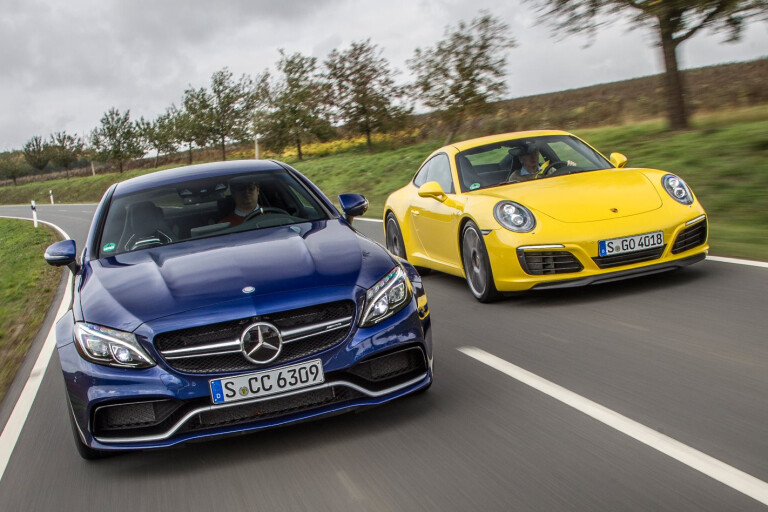
Something is indeed working its way up the mountain. Germany’s Lowenstein ranges hunker in the morning stillness, not unlike ourselves as we sit on a road that ends at a construction site. Company is unlikely. But we are expecting.
Down in the valley a murmur turns to a dim growl, which grows into a bark that’s discernible – if you know your cars, that is.
Two cars; one is clearly a V8 and the other an old friend. Porsche’s 911 is more than 50 years old now, but the entire time it has made more or less the same racket – one a trained ear can spot swirling up a German valley. Yet while the sound is familiar, it’s different just the same. Like a kid whose voice you’ve known, but then he turns 13 and it drops an octave.
 Today our new 911 Carrera S is joined by a hairy-chested AMG coupe. Born in Stuttgart but educated in Affalterbach, the exhaust note has a little of the old school about it. But more so, the new C63 Coupe lets out a modest displacement growl instead of a big-block burble, higher in pitch by virtue of its forced induction, rather than the old cam-in-head gurgle. Still, it’s recognisably V8.
Today our new 911 Carrera S is joined by a hairy-chested AMG coupe. Born in Stuttgart but educated in Affalterbach, the exhaust note has a little of the old school about it. But more so, the new C63 Coupe lets out a modest displacement growl instead of a big-block burble, higher in pitch by virtue of its forced induction, rather than the old cam-in-head gurgle. Still, it’s recognisably V8.
Plonk both these two-door missiles on a drag strip and it’ll be a dead heat to 100km/h, both claiming 3.9sec sprints.
But that’s pretty much where the similarities end. The engines sit at opposite ends of the car, and themselves count different cylinders and displacement. One’s attached to a super-responsive twin-clutch, the other a lazier, more conventional auto. Then there’s the fact one was created as a sportscar from the word go, while the other is, at the end of the day, a variation of what is the most popular taxi in Germany.
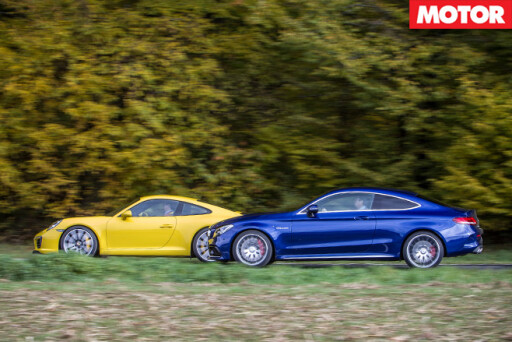 By way of street cred, a comparison necessitates asking where you do your mainies. Up Wall Street the 911 will get more nods, but if you're Bathurst-bound, you’ll make more mates in the C63.
By way of street cred, a comparison necessitates asking where you do your mainies. Up Wall Street the 911 will get more nods, but if you're Bathurst-bound, you’ll make more mates in the C63.
It’s at the Mercedes dealer that the envy and admiration comes a lot cheaper. The C63 S Coupe will cost about $160,000 (price hasn’t been confirmed yet) to the 911 Carrera S PDK’s $258,750.
A higher top speed aside (309km/h versus 290km/h), the extra dough means you will be supporting less of the Middle East economy in the 911, its 7.7L/100km better than the Merc’s 8.9L. But you’ll have to screw a block of wood to the throttle pedal’s backside if you want to get anywhere near those claims.
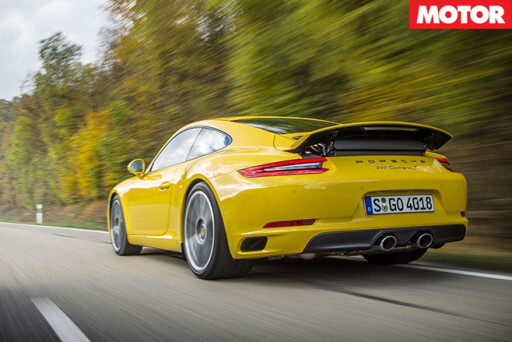 Not too long ago, both these cars were heroes of natural aspiration. Where the old 991’s 3.8-litre flat-six revved like mad, the original C63’s legendary M156 6.2-litre donk dished up a torque tsunami of sorts. But emissions pressures have forced both cars to turbos and fewer cubes, with the promise of more poke for less thirst.
Not too long ago, both these cars were heroes of natural aspiration. Where the old 991’s 3.8-litre flat-six revved like mad, the original C63’s legendary M156 6.2-litre donk dished up a torque tsunami of sorts. But emissions pressures have forced both cars to turbos and fewer cubes, with the promise of more poke for less thirst.
It is the Porsche’s engine that has undergone the greatest personality change. While the C63’s new 4.0-litre twin-turbo V8 still cranks out the torque – and a satisfying V8 soundtrack – the mildly turbocharged Porsche has evolved from something a little hoarse and hungry for revs to an engine with manners and plenty of flexibility.
Power is up 15kW to 309kW, but where the torque curve of a Carrera S used to ramp up with all the aggressiveness of a beginner's ski slope, these days it's more Himalayan, a plateau of 500Nm – an increase of 60Nm – is all yours from 1700rpm to 5000rpm.
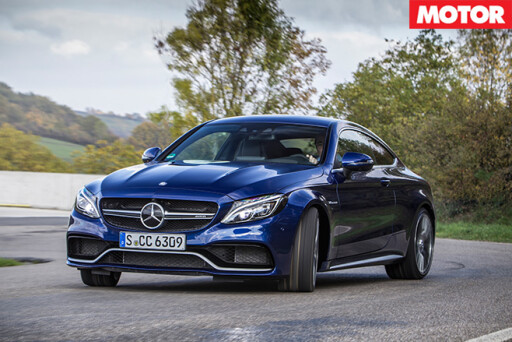 Diesel-locomotive levels of low-down torque is a party trick of the Merc, too. In C63 S guise (all that’s coming to Australia) we’re talking 700Nm from 1750 to 4500rpm, and 375kW. A 205kg weight penalty against the Porsche is reason why the C63 S, despite the extra 200Nm, doesn’t smoke the 911 in a race to the national speed limit, not to mention its engine isn’t exactly sitting over a driven axle. But still, the Porsche will need PDK and Sport Chrono (with launch control) in order to keep the big AMG honest.
Diesel-locomotive levels of low-down torque is a party trick of the Merc, too. In C63 S guise (all that’s coming to Australia) we’re talking 700Nm from 1750 to 4500rpm, and 375kW. A 205kg weight penalty against the Porsche is reason why the C63 S, despite the extra 200Nm, doesn’t smoke the 911 in a race to the national speed limit, not to mention its engine isn’t exactly sitting over a driven axle. But still, the Porsche will need PDK and Sport Chrono (with launch control) in order to keep the big AMG honest.
It’s when the road starts to bend that the C63 is the more entertaining, and frustrating, drive. Laying down all that muscle can be a challenge for the driver as much as the rear tyres, and with the ESP on, you could have as much fun in a C450. But ESP in Handling mode changes the C63 from a punk in hoodie and trackie-dacks to getting out the boxing gloves. And ESP Off, well, if you’re not wide awake you quickly will be.
On paper the Porsche looks hampered by a potentially even-more-ill-fated dynamic weight distribution, yet it hangs on with more skill and corners with greater determination. The bad news is it needs a bigger stage to excel; it’ll cheerfully switch from understeer to oversteer if you clobber the throttle, but the process takes a little longer than the AMG and demands a heavier right foot.
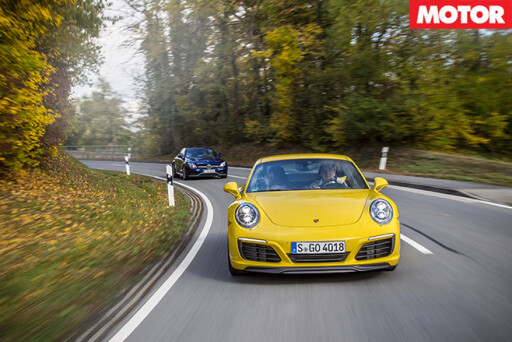 The new ESP Sport Handling mode, at least, knows when you’ve got it all under control and leaves you be. Yet it’ll step in if it all gets a bit loose.
The new ESP Sport Handling mode, at least, knows when you’ve got it all under control and leaves you be. Yet it’ll step in if it all gets a bit loose.
Both cars could sound better, too. Once upon a time car companies couldn’t fit mufflers big enough to these kinds of cars, but now it’s the other way around. In this company there’s no shortage of fake throttle blipping, computer-controlled upshift blats and artificial lift-off fireworks, yet given customers are going for optional sports exhausts, it seems it’s what the masses want.
These days, too, many sportscars try to make everyone happy, being able to tootle to the shops one second and then devour a set of tyres on a track the next. This manifests itself in buttons, and the Porsche is the latest to join the party with its manettino-like steering wheel rotary knob. In Sport Plus it behaves like it’s trying to win a spot on A Current Affair. In Normal and Drive, the excitement levels become limp, the transmission grabs the tallest gear as quickly as possible, and the initial throttle response becomes almost dopey.
 It’s not so extreme in the C63, but in Normal and Auto modes, unless challenged by a restless pedal operator, it’ll still do its best Prius impersonation. Point is, more than ever these cars need their Sports buttons pressed to show any signs of libido. And the new turbo Carrera and C63 Coupe are two of the most extreme examples to date.
It’s not so extreme in the C63, but in Normal and Auto modes, unless challenged by a restless pedal operator, it’ll still do its best Prius impersonation. Point is, more than ever these cars need their Sports buttons pressed to show any signs of libido. And the new turbo Carrera and C63 Coupe are two of the most extreme examples to date.
In their Manual modes, the PDK looks to win out on paper for performance, with its unbelievably quick and crisp shifts up and down. But it’s closer in the real world. The Merc’s Speedshift torque-converted tranny is marginally less efficient but slightly more emotional, able to slam up the gears with impressive rapidity, yet in cruise mode swaps cogs in a manner more relaxed than the Porsche.
On paper, too, the AMG GT might look the more suitable car for comparison with Porsche’s new force-fed Carrera. But, the C63 is the more sorted, sharper and more chuckable back-road missile than its attention-grabbing big brother. It’s the more sensible buy, too.
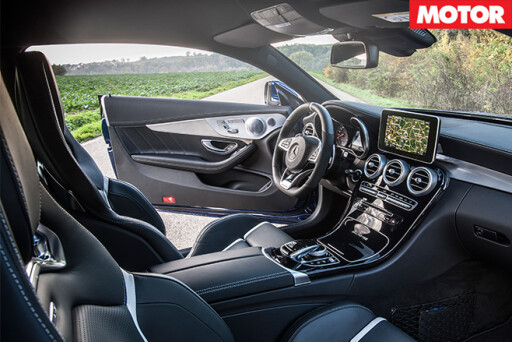 That said, there’s no denying there’s only one hardcore sportscar in this comparison. The C63 is merely a sporty coupe; roomier and more practical, but to an extent compromised by the tall driving position, higher centre of gravity and more generic design, even if the only sheetmetal shared with the normal C-Class Coupe is the doors and roof.
That said, there’s no denying there’s only one hardcore sportscar in this comparison. The C63 is merely a sporty coupe; roomier and more practical, but to an extent compromised by the tall driving position, higher centre of gravity and more generic design, even if the only sheetmetal shared with the normal C-Class Coupe is the doors and roof.
Everything else AMG has made to look meaner; all the flicks, splitters and diffusers will have boy racers in Nissan Silvias trying to race you at the lights. The changes run more than skin deep, too, with AMG thoroughly reworking the suspension, quickening the steering and, of course, installing an engine more than fit for autobahn blasting.
Much like the 911 GTS, the new Carrera S impresses with its polish. But it’s a different car now, no less capable yet more relaxed, progressive and fluent. It’s incredibly well tied down, yet expressive, precise and sublimely balanced, and it includes you in the process of cornering in a way many other so-called sportscars could only dream. Turn-in ability can be truly arresting, stability beyond 200km/h now no longer likely to bring on cardiac arrest, and the extra-cost carbon-ceramic brakes are breathlessly good.
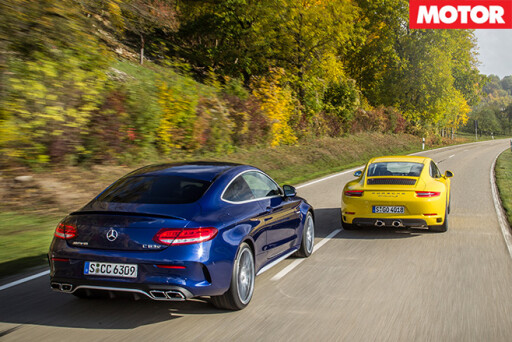 Gripes? On rough roads the 911’s ride often deteriorates from ho-hum to unsettling, while expensive extras like rear-wheel steering or switchable anti-roll bars are as dispensable as the minimum-tolerance sports suspension.
Gripes? On rough roads the 911’s ride often deteriorates from ho-hum to unsettling, while expensive extras like rear-wheel steering or switchable anti-roll bars are as dispensable as the minimum-tolerance sports suspension.
It’s time to wrap up the day, but there’s time for thought as the cars tick themselves cool. The C63’s personality is split in that it’s equally talented a stealth cruiser as attention-grabber in front of the right crowd. Despite its boisterous character and hot-rod soundtrack, it’ll bomb up a road with impressive talent and will be occasionally tricky to tame but always rewarding.
It has got its act together over bumps to the point it’s more confidence-inspiring than the Porsche. Then there’s the practicality element the 911 can’t match, with semi-useable rear seats and a decent boot. The C63 epitomises all the attractions (and flaws) of a rear-drive muscle coupe.
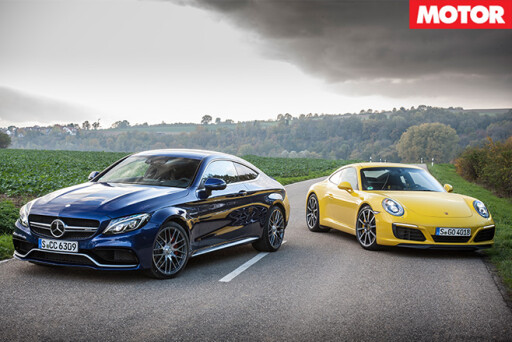 In contrast, the 911 is the more mature choice – a street-faring racecar fitted out to be comfortable, rather than a family car on ’roids. It could also be called the most homogenous 911 ever. Yes, it’s a great car, but only in the context of its more focused siblings like the GT3 and GT3 RS, so far immune to such things as artificial aspiration and excessive driver assistance.
In contrast, the 911 is the more mature choice – a street-faring racecar fitted out to be comfortable, rather than a family car on ’roids. It could also be called the most homogenous 911 ever. Yes, it’s a great car, but only in the context of its more focused siblings like the GT3 and GT3 RS, so far immune to such things as artificial aspiration and excessive driver assistance.
Both the 911 and C63 go like stink, thanks in no small part to some induction assistance, but that’s about all they have in common. The new turbo Carrera S is the most sensible and accessible 911 we’ve driven for a long time, and the two-door C63 the most focused C-Class yet. If price and emotion top your list of criteria, go the blue car. If it’s prestige, panache and perfection, go yellow.
| Porsche 911 Carrera S | Merc-AMG C63 S Coupe | |
| Body | 2-door, 2-seat coupe | 2-door, 4-seat coupe |
| Drive | rear-wheel | rear-wheel |
| Engine | 2981cc flat-6, DOHC, 24v, turbo | 3982cc V8, DOHC, 32v, twin-turbo |
| Bore/stroke | 91.0 x 76.4mm | 83.0 x 92.0mm |
| Compression | 10.0:1 | 10.5:1 |
| Power | 309kW @ 6500rpm | 375kW @ 5500-6250rpm |
| Torque | 500Nm @ 1700-5000rpm | 700Nm @ 1750-4500rpm |
| Power/weight | 203kW/tonne | 217kW/tonne |
| Transmission | 7-speed dual-clutch | 7-speed automatic |
| Weight | 1520kg | 1725kg |
| Suspension(F) | struts, A-arms, adaptive dampers, anti-roll bar | multi-links, coil springs, adaptive dampers, anti-roll bar |
| Suspension(R) | multi-links, coil springs, adaptive dampers, anti-roll bar | multi-links, coil springs, adaptive dampers, anti-roll bar |
| L/W/H | 4499/1808/1295mm | 4750/1877/1400mm |
| Wheelbase | 2450mm | 2840mm |
| Tracks | 1542/1519mm (f/r) | 1636/1592mm |
| Steering | electrically-assisted rack-and-pinion | electrically-assisted rack-and-pinion |
| Brakes(F) | 350mm ventilated discs, 6-piston calipers | 390mm ventilated discs, 6-piston calipers |
| Brakes(R) | 330mm ventilated discs, 4-piston calipers | 380mm ventilated discs, 4-piston calipers |
| Wheels | 20.0 x 8.5-inch (f); 20 x 11.5-inch (r) | 19.0 x 9.0-inch (f); 19 x 10.5-inch (r) |
| Tyre Sizes | 245/35 ZR20 (f); 305/30 ZR20 (r) | 255/35 R19 (f); 285/30 R19 (r) |
| Tyre | Pirelli P-Zero | Michelin Pilot Super Sports |
| Price as tested | $258,750 (PDK) | $160,000 (est.) |
| Pros | Faster and more resolved than ever | Engine; handling; hooligan factor |
| Cons | Some loss of character; extensive options | Rear styling iffy; quite weighty |
| Star Rating | 4/5 | 4/5 |

COMMENTS